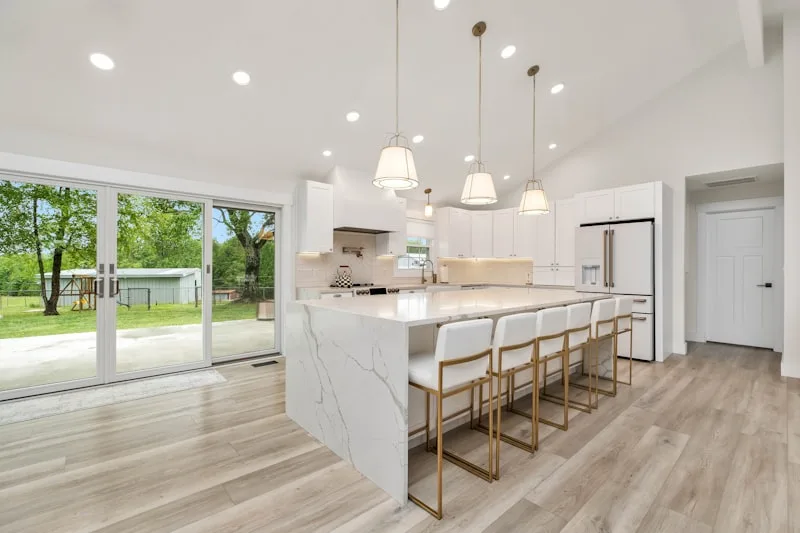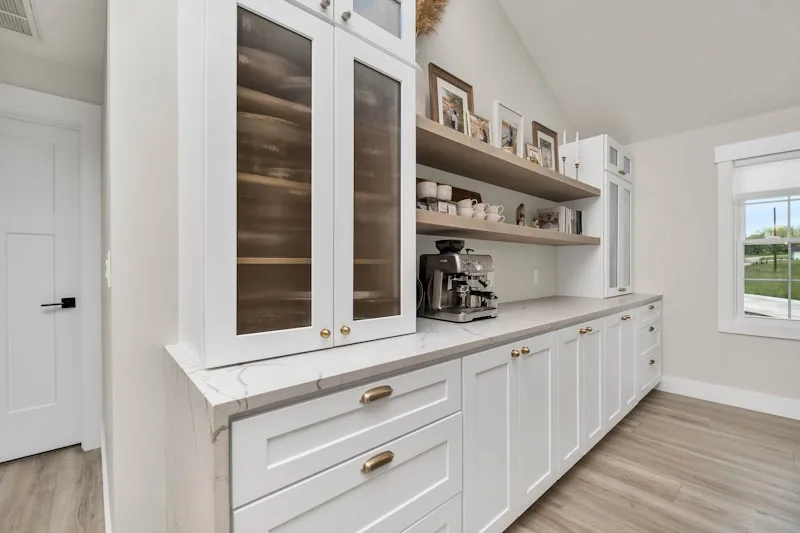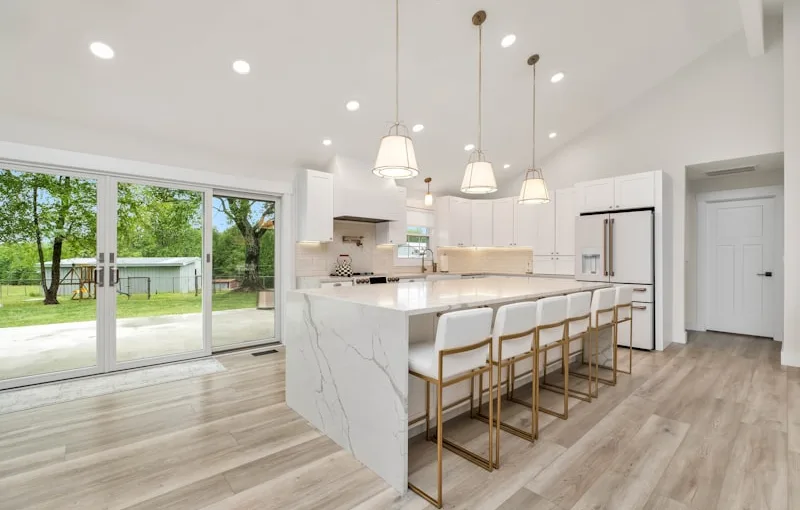First off, let’s talk about the weight. Kitchen cabinets are often loaded with dishes, pots, and all sorts of kitchen gadgets. Over time, that weight can take a toll, especially if the cabinets weren’t properly anchored to the wall. Think of it like a stack of books; if you pile too many on one side, eventually, they’re going to topple over.
Then there’s the issue of humidity. Kitchens can get steamy, and that moisture can cause wood to swell and warp. Imagine a sponge soaking up water—it changes shape, right? Well, your cabinets can do the same, leading to gaps between them and the countertops.
Another sneaky culprit is poor installation. If the cabinets weren’t leveled correctly during installation, they might start to shift over time. It’s like trying to balance a seesaw with one side too high; it just doesn’t work!
Lastly, wear and tear can’t be ignored. Just like your favorite pair of shoes, cabinets can show signs of aging. Hinges can loosen, and screws can become stripped, causing everything to shift out of place.
So, if you’re dealing with loose cabinets, it’s worth investigating these factors. A little maintenance can go a long way in keeping your kitchen looking sharp and functioning smoothly. After all, who wants a kitchen that feels like it’s on the verge of a collapse?
The Hidden Dangers: Why Your Kitchen Cabinets Might Be Coming Loose
First off, let’s talk about the weight. Think about it: those cabinets are carrying a hefty load of pots, pans, and who knows what else. Over time, the screws and brackets that hold them in place can loosen, much like a tight pair of shoes that gradually gives way. If you notice gaps between the cabinet and the wall, or if the doors don’t close properly, it’s a sign that something’s amiss.
But it’s not just the weight that can cause issues. Humidity plays a sneaky role too. Kitchens are often steamy places, and that moisture can warp the wood or weaken the adhesive used in construction. Imagine trying to hold a wet sponge together—it just doesn’t work!

Then there’s the installation factor. If your cabinets were thrown together in a hurry, they might not have been anchored properly. It’s like building a sandcastle without a solid foundation; it’s only a matter of time before it crumbles.
And let’s not forget about pests. Yes, those little critters can wreak havoc on your cabinets, chewing through wood and compromising their integrity. It’s like having an uninvited guest who just won’t leave!
Unraveling the Mystery: Common Causes of Loose Kitchen Cabinets
First off, let’s talk about the screws. Over time, those little metal fasteners can loosen up, especially if your cabinets are packed to the brim with pots, pans, and who knows what else. Think of it like a friendship: if you don’t check in regularly, it might just drift apart. A quick tightening session can work wonders!
Next up, we have the cabinet hinges. These tiny but mighty components bear the weight of your cabinet doors. If they’re worn out or misaligned, it’s like trying to balance a stack of books on a shaky table. You might need to replace them or simply adjust their position to restore stability.
Another sneaky suspect is humidity. If you live in a humid area, the wood in your cabinets can swell and warp, leading to loose fittings. It’s like trying to fit a square peg in a round hole—eventually, something’s gotta give! Keeping your kitchen well-ventilated can help combat this issue.
Lastly, let’s not forget about the installation process. If your cabinets weren’t anchored properly from the get-go, they might be destined for a life of instability. It’s like building a house on sand; without a solid foundation, everything’s bound to crumble.
So, the next time you encounter those pesky loose cabinets, remember these common causes. With a little attention and care, you can restore order to your kitchen and keep your culinary adventures rolling smoothly!
Is Your Kitchen in Danger? Understanding the Risks of Loose Cabinets
Imagine reaching for a spice jar, and suddenly, the cabinet door swings open like a scene from a horror movie. Yikes! Loose cabinets can lead to items falling out unexpectedly, turning your culinary haven into a chaotic mess. Not only can this cause injuries, but it can also damage your precious cookware and dishes. And let’s be honest, nobody wants to deal with a shattered plate or a broken glass in the middle of dinner prep.
But the risks don’t stop there. Loose cabinets can also indicate deeper structural issues. If your cabinets are wobbling, it might be a sign that your walls or foundation are shifting. Think of it like a tree with weak roots; it might look fine on the surface, but a strong wind could bring it crashing down. Ignoring these signs can lead to costly repairs down the line.
From Installation to Wear: Why Kitchen Cabinets Lose Their Grip
When you first install kitchen cabinets, everything feels fresh and sturdy. But as time goes on, factors like humidity, temperature changes, and even the weight of your dishes can take a toll. Imagine your cabinets as a bridge; the more traffic (or weight) they bear, the more stress they endure. If they’re not built with quality materials or installed properly, that stress can lead to warping or loosening of hinges.
Ever noticed how some cabinets seem to sag? That’s often due to poor installation techniques. If the cabinets aren’t level or securely anchored, they can start to shift, making them less reliable. It’s like trying to balance a stack of books on a wobbly table—eventually, something’s got to give.
Then there’s the wear and tear from daily use. Think about how many times you open and close those doors. Each motion adds a little more wear, and over time, the finish can chip or fade, making them look tired and worn out. It’s like a favorite shirt that’s been through the wash one too many times—eventually, it loses its charm.

So, what can you do to keep your kitchen cabinets in tip-top shape? Regular maintenance is key. Just like you’d polish your shoes to keep them looking sharp, a little TLC can go a long way in preserving the beauty and functionality of your cabinets.
Frequently Asked Questions
What Causes Cabinets to Become Loose from Countertops?
Cabinets can become loose from countertops due to several factors, including improper installation, wear and tear over time, moisture damage, or the settling of the building structure. Regular maintenance and ensuring proper installation can help prevent this issue.
How Can I Prevent My Cabinets from Loosening?
To prevent cabinets from loosening, regularly check and tighten screws and hinges. Use quality hardware and consider adding corner braces for extra support. Ensure cabinets are level and properly anchored to the wall. Avoid overloading shelves and distribute weight evenly to maintain stability.
Signs That Your Cabinets Are Coming Loose
Look for gaps between the cabinet doors and frames, uneven alignment, or doors that swing open or closed on their own. Additionally, check for visible screws that are loose or missing, and listen for creaking sounds when opening or closing the cabinets. These signs indicate that your cabinets may be coming loose and require immediate attention.
What Should I Do If My Cabinets Are Loose?
If your cabinets are loose, first check the screws and brackets for tightness. Tighten any loose screws with a screwdriver. If the cabinet is still unstable, consider adding additional brackets or supports. For significant damage, you may need to remove the cabinet and repair or replace the mounting hardware. Ensure the wall anchors are secure and appropriate for the weight of the cabinet.
Can Loose Cabinets Affect My Kitchen Countertops?
Loose cabinets can negatively impact kitchen countertops by causing instability and misalignment. This can lead to uneven surfaces, increased wear and tear, and potential damage to both the cabinets and countertops over time. Ensuring cabinets are securely installed is essential for maintaining the integrity and functionality of your kitchen.
